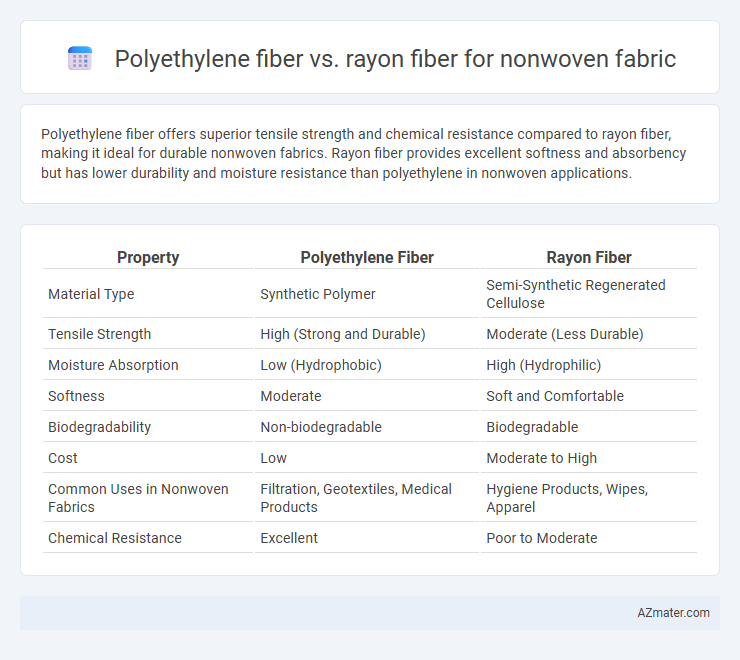Polyethylene fiber offers superior tensile strength and chemical resistance compared to rayon fiber, making it ideal for durable nonwoven fabrics. Rayon fiber provides excellent softness and absorbency but has lower durability and moisture resistance than polyethylene in nonwoven applications.
Table of Comparison
| Property | Polyethylene Fiber | Rayon Fiber |
|---|---|---|
| Material Type | Synthetic Polymer | Semi-Synthetic Regenerated Cellulose |
| Tensile Strength | High (Strong and Durable) | Moderate (Less Durable) |
| Moisture Absorption | Low (Hydrophobic) | High (Hydrophilic) |
| Softness | Moderate | Soft and Comfortable |
| Biodegradability | Non-biodegradable | Biodegradable |
| Cost | Low | Moderate to High |
| Common Uses in Nonwoven Fabrics | Filtration, Geotextiles, Medical Products | Hygiene Products, Wipes, Apparel |
| Chemical Resistance | Excellent | Poor to Moderate |
Introduction to Polyethylene and Rayon Fibers
Polyethylene fibers, derived from polymerized ethylene, are known for their high tensile strength, chemical resistance, and moisture repellency, making them ideal for durable nonwoven fabrics in filtration and protective applications. Rayon fibers, produced from regenerated cellulose, offer superior softness, breathability, and biodegradability, which are essential for comfort-focused nonwoven products like hygiene and medical textiles. Understanding the fundamental properties of polyethylene and rayon fibers helps manufacturers select appropriate materials tailored to performance needs in nonwoven fabric production.
Key Properties of Polyethylene Fiber
Polyethylene fiber exhibits exceptional chemical resistance, low moisture absorption, and high tensile strength, making it ideal for durable nonwoven fabrics in medical and industrial applications. Its lightweight nature and excellent abrasion resistance contribute to enhanced fabric performance and longevity. In contrast, rayon fiber offers superior softness and biodegradability but lacks the hydrophobic and mechanical durability attributes of polyethylene.
Distinctive Features of Rayon Fiber
Rayon fiber in nonwoven fabric is characterized by its high moisture absorbency and soft, silk-like texture, making it ideal for applications requiring comfort and breathability. Unlike polyethylene fiber, rayon is biodegradable and has excellent dyeability, allowing for vibrant, customizable colors without compromising fabric performance. Its natural cellulose base provides enhanced wicking properties, which improve moisture management in hygiene and medical products.
Production Process Comparison
Polyethylene fiber production involves polymerization of ethylene monomers followed by melt spinning, resulting in fibers with high strength and moisture resistance ideal for nonwoven fabrics. Rayon fiber is produced through chemically dissolving cellulose in a viscose process, then extruding and regenerating fibers that offer excellent absorbency and softness. Polyethylene fibers generally require less energy and fewer chemicals compared to the more complex viscose method used for rayon, impacting environmental footprints and production costs for nonwoven fabric manufacturing.
Mechanical Strength and Durability
Polyethylene fiber exhibits superior mechanical strength and durability compared to rayon fiber in nonwoven fabric applications due to its high tensile strength, abrasion resistance, and chemical stability. Polyethylene fibers maintain structural integrity under stress and environmental exposure, making them ideal for long-lasting, heavy-duty products. In contrast, rayon fibers have lower mechanical strength and tend to degrade faster when exposed to moisture and UV light, limiting their durability in demanding nonwoven fabric uses.
Absorbency and Moisture Management
Polyethylene fiber in nonwoven fabrics offers low absorbency and limited moisture management due to its hydrophobic properties, making it ideal for applications requiring water resistance. Rayon fiber, derived from cellulose, provides superior absorbency and efficient moisture wicking, enhancing comfort and breathability in hygiene and medical products. The choice between polyethylene and rayon fibers depends on the specific end-use, balancing moisture control with durability and cost considerations.
Environmental Impact and Sustainability
Polyethylene fiber offers significant advantages in nonwoven fabrics due to its recyclability and lower energy consumption during production compared to rayon fiber, which relies on chemically intensive processes and deforestation-linked cellulose sources. Rayon fiber's biodegradability contrasts with polyethylene's persistence in the environment, leading to complex trade-offs between long-term pollution and immediate ecological harm. Sustainable nonwoven fabric production increasingly favors polyethylene variants engineered for recyclability, while innovations in bio-based rayon aim to reduce chemical usage and improve environmental footprint.
Cost-Effectiveness and Market Availability
Polyethylene fiber offers superior cost-effectiveness for nonwoven fabrics due to its low raw material cost and efficient manufacturing processes, making it highly competitive in large-scale production. Rayon fiber, while providing better absorbency and softness, tends to be more expensive and less readily available, limiting its market presence in cost-sensitive applications. Market availability of polyethylene fibers is broader, driven by high demand in hygiene and filtration products, whereas rayon's niche applications constrain its widespread adoption.
Applications in Nonwoven Fabric Technology
Polyethylene fiber in nonwoven fabric technology offers excellent chemical resistance, high tensile strength, and hydrophobic properties, making it ideal for applications such as filtration, geotextiles, and hygiene products. Rayon fiber provides superior moisture absorption, softness, and biodegradability, which suits medical dressings, wipes, and cosmetic applications. The choice between polyethylene and rayon fibers depends on the specific performance requirements, with polyethylene favored for durability and rayon preferred for comfort and environmental compatibility.
Choosing the Right Fiber for Nonwoven Fabrics
Polyethylene fiber offers superior chemical resistance, high tensile strength, and low moisture absorption, making it ideal for durable and water-repellent nonwoven fabrics used in medical and filtration applications. Rayon fiber provides excellent softness, moisture absorbency, and biodegradability, which is preferred for hygiene products and disposable wipes requiring comfort and environmental sustainability. Selecting the right fiber depends on balancing mechanical properties, environmental impact, and end-use requirements to optimize performance and cost-effectiveness in nonwoven fabric production.

Infographic: Polyethylene fiber vs Rayon fiber for Nonwoven fabric
 azmater.com
azmater.com